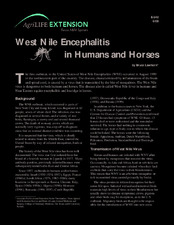West Nile Encephalitis in Humans and Horses
| dc.contributor.editor | GN | |
| dc.creator | Lawhorn, D. Bruce | |
| dc.date.accessioned | 2009-07-20T22:24:28Z | |
| dc.date.available | 2009-07-20T22:24:28Z | |
| dc.date.issued | 2000-08-25 | |
| dc.identifier.other | E-542 | |
| dc.identifier.uri | https://hdl.handle.net/1969.1/86938 | |
| dc.description | 4 pp. | en |
| dc.description.abstract | Humans and horses are infected with West Nile Encephalitis after being bitten by mosquitoes that transmit the virus. Migratory birds are thought to be responsible for the introduction of the virus into new areas. This publication explains the relationship between birds, mosquitoes, humans and horses; discusses the background of the virus; describes symptoms of encephalitis in humans and horses; and explains how to prevent and control it in horses. | en |
| dc.language | en_us | |
| dc.relation.ispartof | Texas FARMER Collection | en |
| dc.subject | Horses | en |
| dc.subject | Birds | en |
| dc.subject | Wildlife | en |
| dc.subject | Health & Safety | en |
| dc.subject | Insects | en |
| dc.title | West Nile Encephalitis in Humans and Horses | en |
| dc.type | Article | en |


